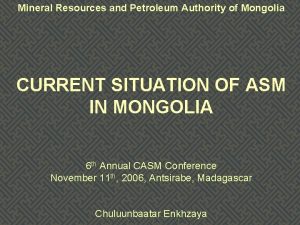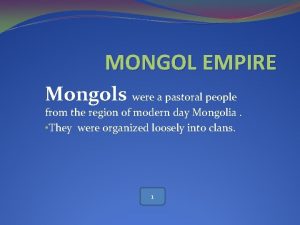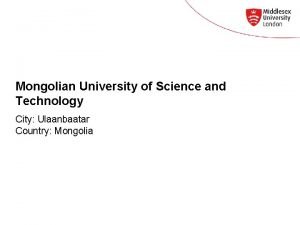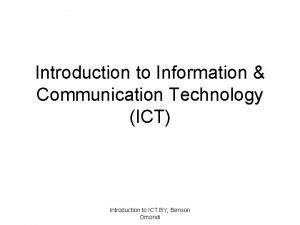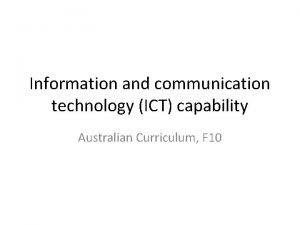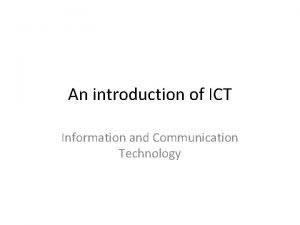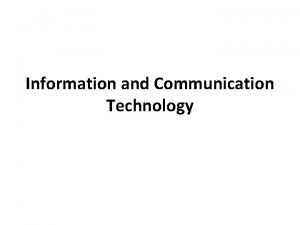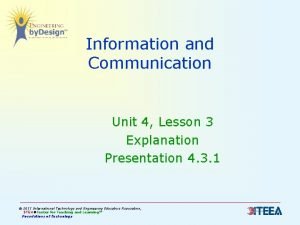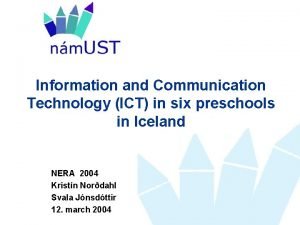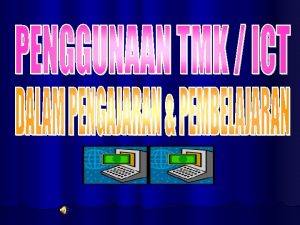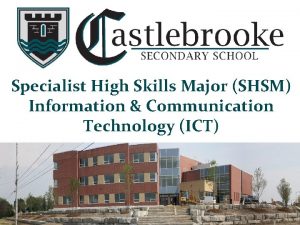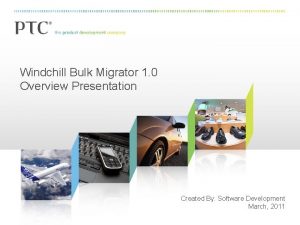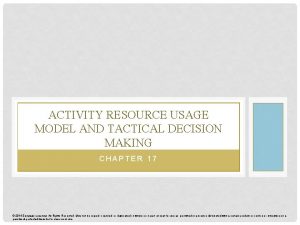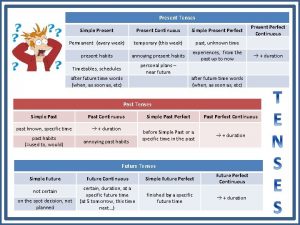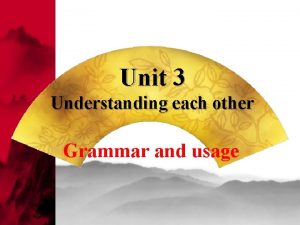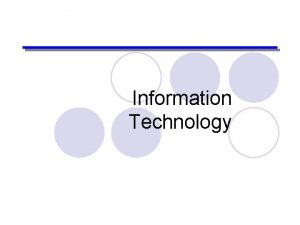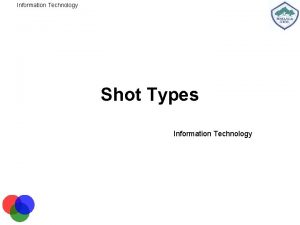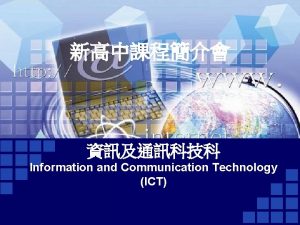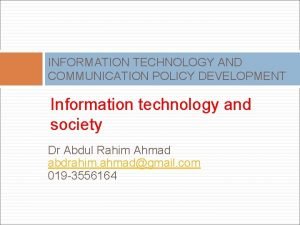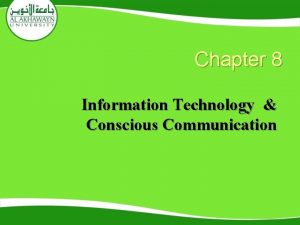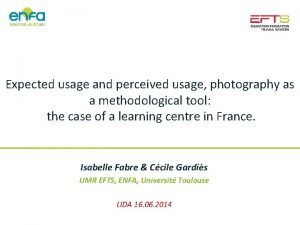Information and Communication Technology Usage in Mongolia for

























- Slides: 25

Information and Communication Technology Usage in Mongolia for DRR Purevnyam B. Senior officer of NEMA purevnyam@nema. gov. mn 0

Contents 1. Brief introduction of Mongolia 2. Early Warning Center of NEMA 3. “Anhaar” mobile application 4. Emergency Information Network center of Ulaanbaatar city 5. Conclusion 1

Background Mongolia • 3. 2 million people • all most half of them live in Ulaanbaatar city (over populated) • Other half sparsely located in 21 provinces • Dry weather – low precipitation in summer • Siberian strong wind • Cold winter with heavy snowfall (dzud) • Western Mongolia - mountainous “high-risk” earthquake zone. 2

Population Density 3

Natural Disasters in Mongolia 4

Relevant Government Agencies 5

EMERGENCY MANAGEMENT AND EARLY WARNING CENTER

Earthquake disaster warning system /EDWS/ • Government of Mongolia jointly with KT corporation of the South Korean telecommunication provider have conducted EDWS project from 2012 to 2014. • The EDWS project was initiated and funded by Government of Mongolia as ITPTA (Information Technology, Post and Telecommunication Authority) jointly with NEMA of Mongolia in 2012. • Government of Mongolia implemented EDWS project with two phases in 2012 -2014. 7

Earthquake disaster warning system /EDWS/ • In 2013, phase one of the abovementioned project was completed, which included a Control center (CC), forty siren towers, three TV and five radio systems. Phase two, which included a mobile control center and twelve earthquake monitoring sensors, twenty siren towers, five radio systems, was concluded in 2014. • This system will gather, analyses data being fed from sensors and broadcast information to respective stakeholders using wireless or wired networks in case of disaster. • Warning methods consist of siren tower, EBS (TV and Radio) and CBS (Cell broadcasting Service for mobile network operator). 8

GENERAL STRUCTURE OF EDWS Satellite Hub Station RCAG Siren tower 60 set Fiber optic cable 3 sec Earthquake sensor and recorder-12 set Mobile network operators-2 NAMEM Total: 24 -30 sec 15 -17 sec Analyze @ calculate Radio repeater-4 (VHF) 8 -10 sec Control Center (NEMA) Mobile Control Center EMERGENCY COMMUNICA TIONS CENTER NEMA EBS TV-3 FM-10

Control center The Control Center (CC): Is the main unit of EDWS system. The CC provides one-stop command control features with automatic feedback system across the communication network. During normal conditions, the CC will monitor the network connection and status of all Siren towers in order to ensure their readiness at all times. Under emergency situations, authorized staff in the CC will issue warning command immediately. Also in case the CC fails, there is a Mobile CC for back-up. 10

Siren Tower The key element of the Siren station is remote siren terminal (RST) which has a reliable performance. RST is designed for remote siren activation from CC, and generates various patterns of siren signals to notify the emergency situation to the public. RST automatically reports the activation result to the CC after the command execution. Live voice warning messages from CC can be remotely delivered to the public for more clear notifications of the emergency situations. 11

Emergency broadcast system /EBS/ The Emergency Broadcasting System (EBS): Sends notifications from CC or the Mobile CC to radio broadcasting station using audio data and to the TV broadcasting station through text message. EBS reports the result of notifications to the Centers. This system is connected to CC via Satellite and VHF network. Other functions for maintenance include recording the history of operation and reporting the result of notifications, self-tests, status displays etc. 12

Emergency broadcast system /EBS/ 13

Cell broadcast service /CBS/ The Cell Broadcast Service (CBS) is a service where emergency messages can be sent to mobile handsets in an area to warn citizens. EDWS system in NEMA CC System CBIS Disaster information Send command Disaster information BSC Officer in charge of system Cellular Residends BSC CBC Simple cell phone BSC 14

Early Warning SMS Delivering System The Emergency Operations Center delivers disaster and emergency early warning short messages to the all users of national mobile operators ‘Mobicom’ and ‘Unitel’ through 2 G system. 15

Safety guide - “ANHAAR” Mobile application

Application components: The measures to get information about common disasters List of essential phones for emergency calls Instruction for giving First Aid Equipments /flash light, alarm sound, use as a flashlight/

Available to install types of smart phones with the operating system more than Android 2. 2; IOS 6. 1 Safety guide - “ANHAAR” Mobile application

Emergency Information Network center of Ulaanbaatar city (Emergency Call Center) www. eincenter. mn

Emergency Information Network center (Emergency Call Center) . . 101, 105 - Emergency 102 - Police 103 - Ambulance PSTN

Emergency Information Network center (Emergency Call Center) The whole system of this service was designed and completed by “LG” corporation of South Korea. The service started going live since Jun 2010 and all information is disseminated and shared via fiber optic among emergency management agency, police, and all units under hospitals in Ulaanbaatar.

ICT structure of EIN center

Conclusion • More financial and technical support to facilitate necessary technology for ICT development. • Proper legislation on how to regulate the communication between private landowners, legal entities. • Cooperation with Governments of other countries on sharing information and learning best practices. • Effective communication with the mass media. • Awareness rising and promotion as well as basic education regarding disaster preparedness. • Digital divide (urban and rural areas) and Universal service obligation fund issues. 23

Thank you for your attention Thank you for your 24
 Mineral resources and petroleum authority of mongolia
Mineral resources and petroleum authority of mongolia Twin lakes mongolia
Twin lakes mongolia Marco polo history
Marco polo history Jds mongolia
Jds mongolia Mongolian technical university
Mongolian technical university What did the mongols do for the silk road
What did the mongols do for the silk road Fagiano mongolia
Fagiano mongolia Conclusion ict
Conclusion ict Introduction of ict
Introduction of ict Information and communication technology capability meaning
Information and communication technology capability meaning Introduction of ict
Introduction of ict What is ict means
What is ict means Components of information and communication technology
Components of information and communication technology Definition information and communication technology
Definition information and communication technology Information use
Information use Apa itu technology
Apa itu technology Shsm ict
Shsm ict Windchill bulk migrator
Windchill bulk migrator Developing skills grammar & usage set b answer
Developing skills grammar & usage set b answer Advice from tablets for schools to avoid computer addiction
Advice from tablets for schools to avoid computer addiction Activity resource usage model and tactical decision making
Activity resource usage model and tactical decision making Activity resource usage model and tactical decision making
Activity resource usage model and tactical decision making Present simple present continuous present perfect
Present simple present continuous present perfect Unit 3 grammar and usage
Unit 3 grammar and usage Should vs must
Should vs must Unit 3 grammar and usage
Unit 3 grammar and usage
